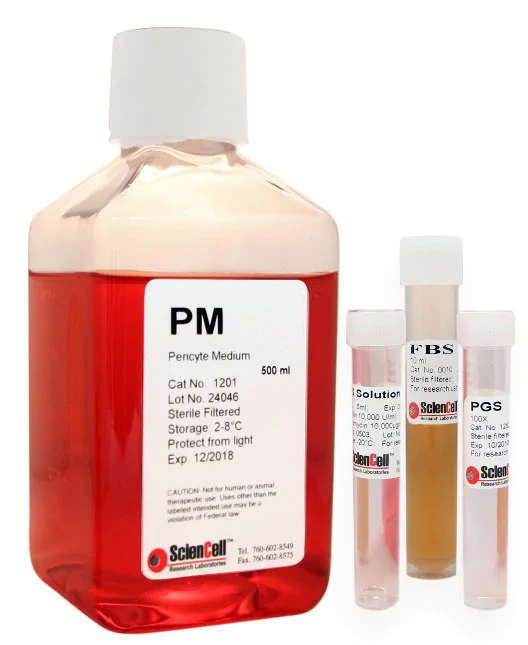Pericyte Medium
Product Code:
SC-1201
SC-1201
Host Type:
Human
Human
Regulatory Status:
RUO
RUO
Shipping:
Dry Ice
Dry Ice
No additional charges, what you see is what you pay! *
| Code | Size | Price |
|---|
| SC-1201 | 500 ml | £160.00 |
Quantity:
Prices exclude any Taxes / VAT
Stay in control of your spending. These prices have no additional charges, not even shipping!
* Rare exceptions are clearly labelled (only 0.14% of items!).
* Rare exceptions are clearly labelled (only 0.14% of items!).
Multibuy discounts available! Contact us to find what you can save.
This product comes from: United States.
Typical lead time: 10-14 working days.
Contact us for more accurate information.
Typical lead time: 10-14 working days.
Contact us for more accurate information.
- Further Information
- Documents
- References
- Related Products
- Show All
Further Information
Description:
Pericyte Medium (PM), when used with Pericyte Growth Supplement (PGS, Cat #1252) and 10 ml of fetal bovine serum (FBS) is a complete medium designed for optimal growth of normal pericytes in vitro . It is a sterile, liquid medium which contains essential and non-essential amino acids, vitamins, organic and inorganic compounds, hormones, growth factors, trace minerals and a low concentration of fetal bovine serum (2%). The medium is HEPES and bicarbonate buffered and has a pH of 7.4 when equilibrated in an incubator with an atmosphere of 5% CO2/95% air. The medium is formulated (quantitatively and qualitatively) to provide an optimally balanced nutritional environment that selectively supports the growth of normal pericytes in vitro .
Extra Description:
PM consists of 500 ml of basal medium, 10 ml of FBS (Cat. #0010), 5 ml of Pericyte Growth Supplement (PGS, Cat. #1252) and 5 ml of penicillin/streptomycin solution (P/S, Cat. #0503). Note: FBS, PGS and P/S are not pre-mixed in PM; they must be added separately to make the complete PM.
Documents
References
- https://cancerres.aacrjournals.org/cgi/reprint/65/21/9741
- https://pubmed.ncbi.nlm.nih.gov/23448258/
- https://doi.org/10.1371/journal.pone.0076834
- https://doi.org/10.5607/en.2013.22.4.315
- https://doi.org/10.1016/j.mvr.2012.03.008
- https://doi.org/10.1007/s10456-013-9378-1
- http://journals.plos.org/plosone/article/asset?id=10.1371/journal.pone.0124362.PDF
- http://www.ncbi.nlm.nih.gov/pmc/articles/PMC4442416/pdf/zjv5862.pdf
- https://journals.plos.org/plospathogens/article?id=10.1371/journal.ppat.1004963
- http://www.ncbi.nlm.nih.gov/pmc/articles/PMC4594676/pdf/jcmm0019-2341.pdf
- https://pubmed.ncbi.nlm.nih.gov/26915562/
- http://pubs.acs.org/doi/pdfplus/10.1021/acsbiomaterials.5b00064
- https://doi.org/10.1186/s12974-014-0219-y
- https://pubmed.ncbi.nlm.nih.gov/26194913/
- https://www.ahajournals.org/doi/10.1161/circ.130.suppl_2.16306
- http://www.ncbi.nlm.nih.gov/pmc/articles/PMC4679401/
- http://www.nature.com/articles/ncomms11415
- https://www.ncbi.nlm.nih.gov/pubmed/29471788
Related Products
| Product Name | Product Code | Supplier | Fetal Bovine Serum | SC-0010 | Sciencell | Summary Details | |||||||||||||||||||||||||||||||||||||||||||||||||||||||||||||||||||||||||||||||||||||||||||||
|---|---|---|---|---|---|---|---|---|---|---|---|---|---|---|---|---|---|---|---|---|---|---|---|---|---|---|---|---|---|---|---|---|---|---|---|---|---|---|---|---|---|---|---|---|---|---|---|---|---|---|---|---|---|---|---|---|---|---|---|---|---|---|---|---|---|---|---|---|---|---|---|---|---|---|---|---|---|---|---|---|---|---|---|---|---|---|---|---|---|---|---|---|---|---|---|---|---|---|---|
| Penicillin/Streptomycin Solution | SC-0503 | Sciencell | Summary Details | ||||||||||||||||||||||||||||||||||||||||||||||||||||||||||||||||||||||||||||||||||||||||||||||||
| Pericyte Medium-basal | SC-1201-b | Sciencell | Summary Details | ||||||||||||||||||||||||||||||||||||||||||||||||||||||||||||||||||||||||||||||||||||||||||||||||
| Pericyte Medium-basal-phenol red free | SC-1201-b-prf | Sciencell | Summary Details | ||||||||||||||||||||||||||||||||||||||||||||||||||||||||||||||||||||||||||||||||||||||||||||||||
| Pericyte Medium-Glucose Free | SC-1201-gf | Sciencell | Summary Details | ||||||||||||||||||||||||||||||||||||||||||||||||||||||||||||||||||||||||||||||||||||||||||||||||
| Pericyte Medium-No Glutamine | SC-1201-ng | Sciencell | Summary Details | ||||||||||||||||||||||||||||||||||||||||||||||||||||||||||||||||||||||||||||||||||||||||||||||||
| Pericyte Medium-phenol red free | SC-1201-prf | Sciencell | Summary Details | ||||||||||||||||||||||||||||||||||||||||||||||||||||||||||||||||||||||||||||||||||||||||||||||||
| Pericyte Growth Supplement | SC-1252 | Sciencell | Summary Details | ||||||||||||||||||||||||||||||||||||||||||||||||||||||||||||||||||||||||||||||||||||||||||||||||



